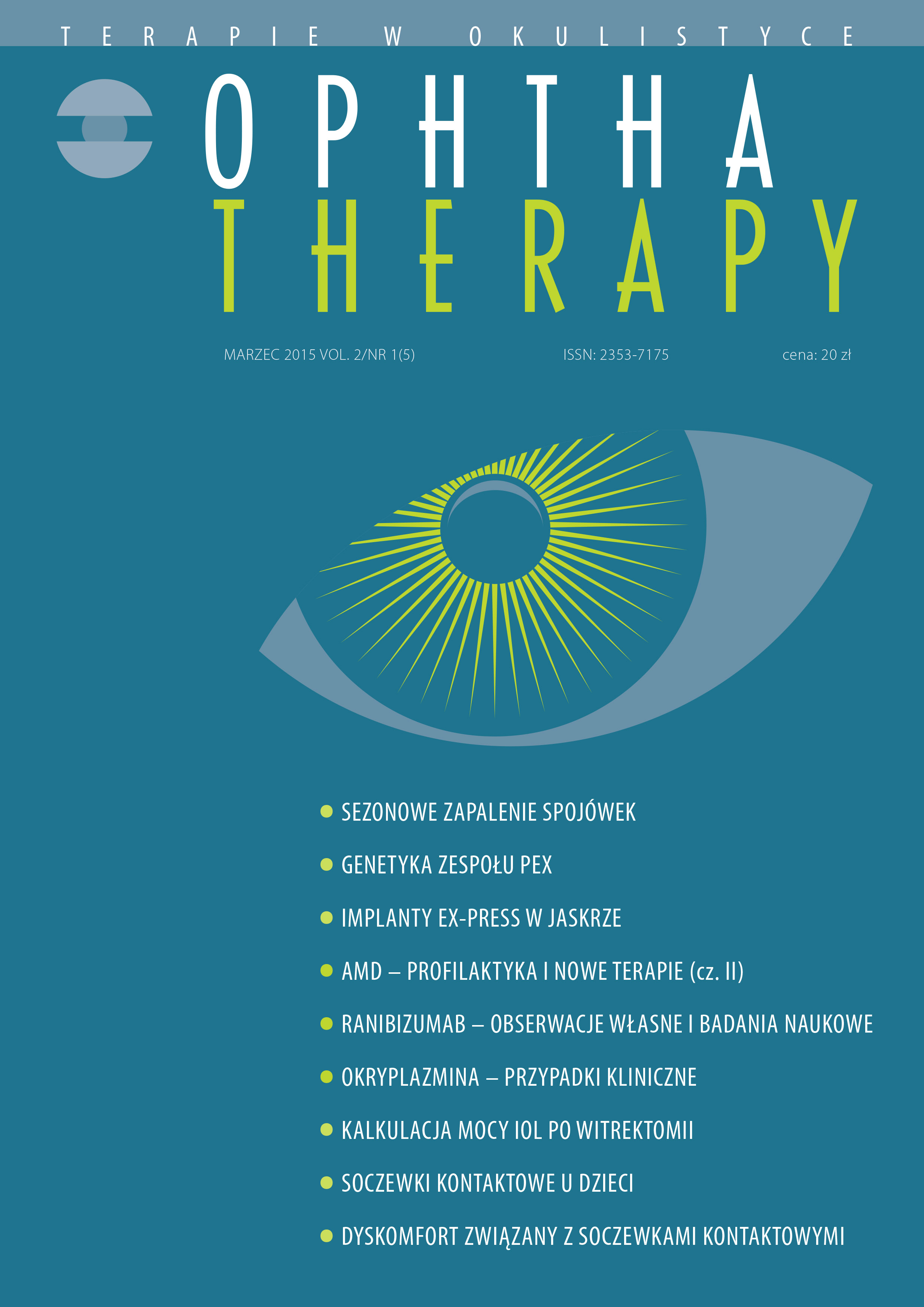Ranibizumab for wet AMD ? several years own observations of patients with preserved good visual acuity despite of extensive subretinal neovascularization
Main Article Content
Abstract
In everyday clinical practice, results of therapy for age-related macular degeneration in long-term observation, especially in patients with risk factors of visual loss like large area of subretinal neovascularization, may be different from results obtained in clinical studies. In this paper clinical cases of three patients were presented, in whom despite of large subretinal neovascularization, long- term ranibizumab therapy preserved good visual acuity. Factors influencing prognosis in patients with wet age-related macular degeneration treated with ranibizumab were analyzed.
Downloads
Article Details

This work is licensed under a Creative Commons Attribution-NonCommercial-NoDerivatives 4.0 International License.
Copyright: ? Medical Education sp. z o.o. License allowing third parties to copy and redistribute the material in any medium or format and to remix, transform, and build upon the material, provided the original work is properly cited and states its license.
Address reprint requests to: Medical Education, Marcin Kuźma (marcin.kuzma@mededu.pl)
References
2. Kaiser P, Blodi B, Shapiro H et al; MARINA Study Group. Angiographic and optical coherence tomographic results of the MARINA study of ranibizumab in neovascular age-related macular degeneration. Ophthalmology. 2007; 114(10): 1868-75.
3. Brown D, Kaiser P, Michels M et al; ANCHOR Study Group. Ranibizumab versus verteporfin for neovascular age-related macular degeneration. N Engl J Med. 2006; 355(14): 1432-44.
4. Fung A, Lalwani G, Rosenfeld P et al. An optical coherence tomography-guided, variable dosing regimen with intravitreal ranibizumab (Lucentis) for neovascular age-related macular degeneration. Am J Ophthalmol. 2007; 143(4): 566-83.
5. Lalwani G, Rosenfeld P, Fung A et al. A variable-dosing regimen with intravitreal ranibizumab for neovascular age-related macular degeneration: year 2 of the PrONTO Study. Comparison of Age-related Macular Degeneration Treatments Trials (CATT) Research Group. Am J Ophthalmol. 2009; 148(1): 43-58.
6. Martin D, Maguire M, Fine S et al. Ranibizumab and bevacizumab for treatment of neovascular age-related macular degeneration: two-year results. Ophthalmology. 2012; 119(7): 1388-98.
7. Singer M, Awh C, Sadda S et al. HORIZON: an open-label extension trial of ranibizumab for choroidal neovascularization secondary to age-related macular degeneration. Ophthalmology. 2012; 119(6): 1175-83.
8. Rofagha S, Bhisitkul R, Boyer D et al. SEVEN-UP Study Group. Seven-year outcomes in ranibizumab-treated patients in ANCHOR, MARINA, and HORIZON: a multicenter cohort study (SEVEN-UP). Ophthalmology. 2013; 120(11): 2292-9.
9. Rasmussen A, Bloch S, Fuchs J et al. A 4-year longitudinal study of 555 patients treated with ranibizumab for neovascular age-related macular degeneration. Ophthalmology. 2013; 120(12): 2630-36.
10. Coco R, Sanabria M, Castrejon M et al. Funduscopic results after 4-year follow-up treatment with ranibizumab for age-related macular degeneration in a region of Spain. BMC Ophthalmol. 2014; 14: 138.
11. Ying G, Huang J, Maguire M et al; Comparison of Age-related Macular Degeneration Treatments Trials Research Group. Baseline predictors for one-year visual outcomes with ranibizumab or bevacizumab for neovascular age-related macular degeneration. Ophthalmology. 2013; 120(1): 122-9.
12. Korb C, Zwiener I, Lorenz K et al. Risk factors of a reduced response to ranibizumab treatment for neovascular age-related macular degeneration ? evaluation in a clinical setting. BMC Ophthalmol. 2013; 13: 84.
13. Holz F, Bandello F, Gillies M et al. LUMINOUS Steering Committee. Safety of ranibizumab in routine clinical practice: 1-year retrospective pooled analysis of four European neovascular AMD registries within the LUMINOUS programme. Br J Ophthalmol. 2013; 97(9): 1161-7.
14. Wolf A, Kampik A. Efficacy of treatment with ranibizumab in patients with wet age-related macular degeneration in routine clinical care: data from the COMPASS health services research. Graefes Arch Clin Exp Ophthalmol. 2014; 252(4): 647-55.
15. Krüger Falk M, Kemp H, S?rensen T. Four-year treatment results of neovascular age-related macular degeneration with ranibizumab and causes for discontinuation of treatment. Am J Ophthalmol. 2013; 155(1): 89-95.
16. Barthelmes D, Walton R, Campain A et al; for the Fight Retinal Blindness! Project Investigators. Outcomes of persistently active neovascular age-related macular degeneration treated with VEGF inhibitors: observational study data. Br J Ophthalmol. 2014 Sep 23. pii: bjophthalmol-2014-305514.
17. Ying G, Kim B, Maguire M et al. CATT Research Group. Sustained visual acuity loss in the comparison of age related macular degeneration treatments trials. JAMA Ophthalmol. 2014; 132(8): 915-21.
18. Daniel E, Toth C, Grunwald J et al; Comparison of Age-related Macular Degeneration Treatments Trials Research Group. Risk of scar in the comparison of age-related macular degeneration treatments trials. Ophthalmology. 2014; 121(3): 656-66.
19. Grunwald J, Daniel E, Huang J et al; CATT Research Group. Risk of geographic atrophy in the comparison of age-related macular degeneration treatments trials. Ophthalmology. 2014; 121(1): 150-61.
20. Bhisitkul R, Mendes T, Rofagha S et al. Macular atrophy progression and 7-year vision outcomes in subjects from the ANCHOR, MARINA and HORIZON studies (SEVEN-UP Study). Am J Ophthalmol. 2015 Jan 29. pii: S0002 9394(15)00061-6.

